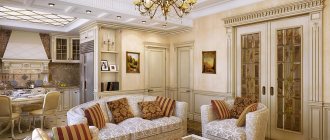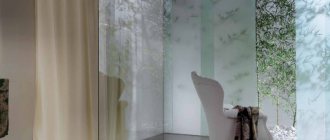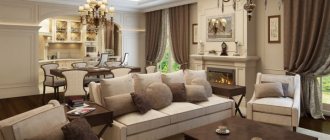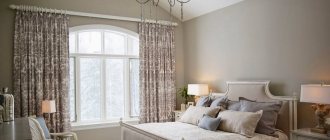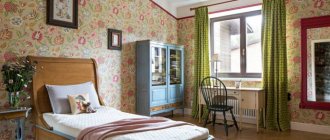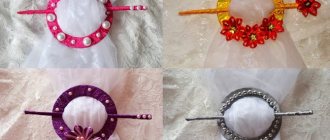Classics in the interior remain in demand and relevant today and will not go out of fashion for a long time. Therefore, we determine which curtains can be called classics, and how to correctly choose curtains in a classic style for the living room. Let's consider the positive aspects and disadvantages of the decision to purchase such curtains. We’ll tell you how diverse the choice of classic curtains is and give some methods for attaching them.
Classic style curtains Source plpstatic.ru
Where do curtains in a classic style begin?
To choose the right curtains, you need to have at least a little understanding of the canons of the classical style. There are several peculiar laws that give this interior detail the necessary appearance:
Synthetics are not allowed! The material should be natural and expensive: velvet, satin. The proportions of the curtains must correspond to the dimensions of the window opening. Otherwise, the composition will look funny and disproportionate.
Large windows - lots of folds and tassels. Small windows - a minimum of frills. Do not clutter up a small space with a huge number of details.
Dark colors are suitable for spacious rooms and have a detrimental effect on the appearance of miniature rooms. Classic curtains are good because they are very easy to choose. You just need to follow these simple rules.
What fabrics are suitable
One of the reasons that allows classics to remain popular at all times is the nobility of fabrics. The materials used for them are both natural and artificial. Drapery made from natural fabrics such as velvet, silk, cotton will look expensive and elegant, but will also quickly fade in the sun, wrinkle and get dirty. Artificial materials look no worse, are less susceptible to fading, are easy to care for, and a variety of colors will suit different styles of the room.
The material for curtains, as well as lambrequins, must be dense and heavy so that they retain their shape: jacquard, velvet, satin, cotton, linen, chenille, brocade, taffeta. Jacquard curtains are resistant to fading in the sun; velvet and corduroy have a beautiful relief pattern, which allows you to look luxurious, and they are also very durable. You can create a beautiful multi-layer composition from brocade (examples in the photo).
The material used for the curtains should be light, transparent (to allow daylight to pass through), creating soft folds, fabric. Usually it is a veil, organza, tulle, cambric. The canvas is gathered into vertical folds, and its bottom can be either smooth or wavy, or gathered into scallops.
Dense heavy fabrics
Living room interior
English style
Brocade
Classic in the living room
Small classification
Looking at the photo of classic curtains, you can see that many compositions use more than one type of these curtains. Indeed, there are several types of curtains, the appearance of which differs significantly:
Roman. The simplest and most economical option. They form folds perpendicular to the floor, covering the entire window space. Typically dense. They do not require frequent and tedious maintenance.
Mounting options
You can attach curtains to the curtain rod in different ways:
- Hooks
- Eyelets
- Backstage
- Fabric loops
Hooks are the simplest and most primitive method, suitable for ceiling cornices. The eyelets are attached to the fabric itself and through them the curtain is put on the curtain rod. The curtain is a tunnel in the curtain where the cornice is “hidden”. The ties and loops are sewn together with a curtain made of the same or similar fabric.
Classic curtains with drawstring
Classic curtains with eyelets
Classic hinges
Classic curtains with loops
Long curtains
They are decorative in nature, gathered along the edges of the windows using special garters. Made from expensive fabric. Of course, they need additions.
Often this is a translucent light curtain that bends in waves and covers the window from ceiling to floor. Such classic curtains for the living room look luxurious, but require maintenance.
French
Most often they are equipped with a lifting mechanism and look harmonious on wide and tall windows. Ideal curtains for a classic kitchen.
Translucent lightweight fabric hangs in small waves and usually covers half of the window space. This composition looks light and harmonious.
What should be the ideal width?
The overall appearance of the curtains is affected by the width of the curtains and curtains; incorrectly selected sizes can ruin the entire impression of the composition. The ideal ratio is the width of the curtains to be twice the length of the cornice. At the same time, beautiful vertical folds are formed on the curtain; without them, the curtain looks defective.
However, if the room is not spacious enough, the width of the curtains or curtains can be made somewhat smaller. It is better to limit the number of folds; their excess will seem inappropriate.
Lambrequin
It is often an addition, but can act as an independent element. The main role of the lambrequin is to decorate the upper part of the window, giving it a neat and graceful outline.
Can often go down and up. It is made in different variations: hard and soft, dense and slightly transparent.
What to consider when choosing curtains
In order for curtains to harmoniously complement the overall design of the apartment and last a long time, it is necessary to choose them correctly.
There are several basic criteria that must be taken into account by both amateurs and experienced designers:
Compatibility and appropriateness
Of course, the curtains should become one with the interior appearance of the home. To do this, use several simple techniques:
- Similarity of colors. For example, curtains for a classic-style bedroom can match the color of the bed linen or bedspread. This similarity unites disparate interior details into a single composition.
- Ornament and coloring. The strict style of the living room is combined with the same laconic appearance of the curtains. Children's room implies bright and rich colors of curtains. The design of curtains in the bedroom in a classic style is calm and peaceful, without sharp lines or changes in shades.
- We take into account the dimensions. Complex sets of curtains in cold and dark shades are strictly for large spaces. Yes, such curtains look very rich and beautiful, but they are unacceptable for small rooms and windows. Light and airy curtains correspond to cramped rooms, visually expanding the space.
- We calculate the possibilities. Curtains are an interior attribute that requires constant care. Complex curtains with an abundance of tassels and folds must be frequently dusted and washed, and any stains stand out extremely clearly on light-colored fabrics. It is necessary to choose curtains whose care will not take a critical amount of time and effort.
Selection of colors
Choosing the right color is extremely important. You can choose patterned curtains that will become a bright accent. But in this case, you need to make sure that the pattern on the curtains is repeated in the wallpaper and upholstery of upholstered furniture. Or you can choose curtains to match the furniture or decoration. A good option would be classic curtains to match the color of the kitchen facade, the Persian carpet in the living room or the bedspread in the nursery.
Light, muted colors have the ability to visually expand space, while deep, warm colors allow you to visually reduce the area. All these nuances must be taken into account when choosing curtains for a small room.
Classic design loves a white and beige palette. Such color schemes can be diluted with chocolate-colored pick-ups, bright edging, and silver tassels.
If you want to highlight a window, then designers recommend two- or three-color curtains with wide stripes.
Plain curtains are appropriate in a room with wallpaper decorated with patterns. And, on the contrary, it is better to combine curtains with a pattern with plain walls. If the wall decoration has a light texture, then you can choose curtains with ornaments to match its color.
Classic curtains - versatility and practicality
Such window curtains not only suit almost any interior, but also provide residents with a special atmosphere.
Curtains also cover the window space if necessary, which is often necessary for residents of low-rise buildings. Thick fabric reliably protects the apartment from prying eyes and gives household members a feeling of confidence and peace.
Classic elements
Classic curtains are a combination of curtains made of heavy, dense fabric with the formation of vertical folds, a lambrequin and a mandatory element: a curtain (a curtain made of transparent lightweight fabric). The lambrequin is placed on top of the curtains and drapes. The lining makes the curtain even heavier, protects it from sunlight and serves as an additional decoration.
Along its length, the curtain can almost touch the floor, or lie on it. Tiebacks with tassels or fringes are used as additional decorative elements. Cords, braids, ribbons, ruffles, beads and other decorations are used. All decorative elements and the composition of curtains as a whole must be selected taking into account the overall design of the room.
Floral ornament
The canvases lie on the floor
Tiebacks
Turquoise in the interior
Lambrequins and tiebacks

